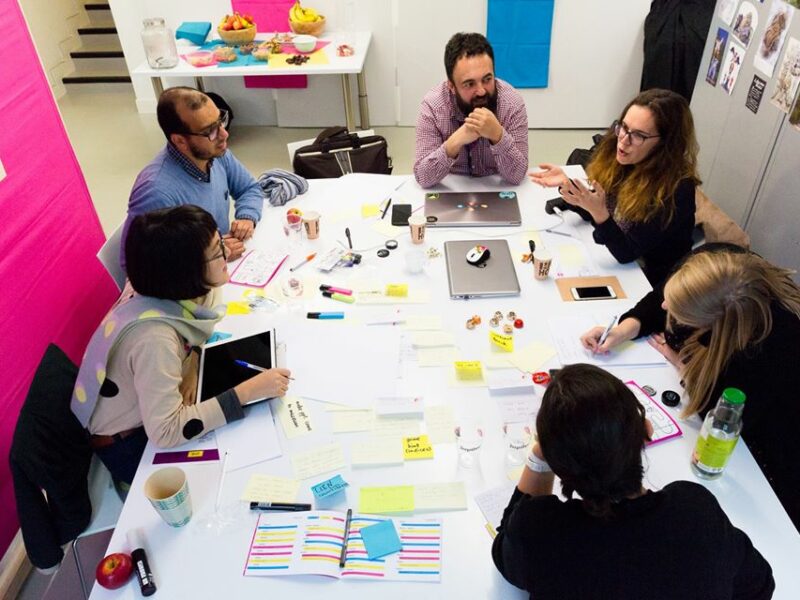Design Thinking
Design Thinking is a design and innovation process based on the needs of users. This method facilitates problem-solving and optimal design of products and services. But what are the main stages of the Design Thinking approach? How can it be applied to graphic design?

Brainstorming phase during hackathon Museomix (annual event) at the BAM museum in Mons
What is Design Thinking?
Design Thinking is a method of innovation management which facilitates combining the analytical skills of some participants with the intuitive skills of others. This approach, which is also based on methods such as observation and immersion, relies significantly on a process of co-creation involving feedback from the end user.
The main objective of Design Thinking is to develop the creativity of participants to create or improve a product or service and resolve a problem. This way of thinking and innovating departs from the initial question to then find solutions to improve the problem.
For several years, Design Thinking has been used successfully by companies such as Airbnb, Greenpeace and Apple. The best known supporters of this concept are Rolf Faste, Jeremy Gutsche and Tim Brown.
The 5 stages of Design Thinking
Design Thinking comprises several stages. The number of stages varies according to the creators. Rolf Fast initially established the design thinking process in 7 stages (define, research, ideate, prototype, select, implement, learn). Jeremy Gutsche reduced these down to five (define, ideate, synthesise, prototype and test).
Here is the 5-stage approach from Stanford d.school, the design school of Stanford University.
1. Define the target
The first phase of the Design Thinking process examines the target of the project. Who are your users? What are their situations, motivations, issues? During this first stage, observation, exchange and empathy enable the team leading the new project to put themselves in the place of the user and understand their needs. The idea is to create an ideal client or persona: a fictional person symbolising a profile type of consumers. The objective is to get to know their way of life, their thoughts and feelings, to walk in their shoes and better understand their needs.
Example: You want to create a magazine. The first stage will be to define who your future readers will be.
2. Define the issue
The second stage of Design Thinking consists of identifying the issue facing the user and evaluate the environment in which it evolves. What issues are encountered? How do they come about and how long have they been experienced? Leads begin to emerge that will improve the product or service to resolve the specific issue in question.
Example: During this stage research is undertaken, an overview of competitors is observed, and the expectations of readers are determined, etc.
3. Imagine the Solution
Then comes the time to find the innovation, the solution which will make it possible to resolve the issue. This third stage of the Design Thinking process is also known as the “ideation phase“. All possible ideas stream forth to resolve the issue.
Different methods facilitate finding ideas:
- Brainstorming
- Debate
- Mind Mapping
- Etc.
To put all participants at ease, the “worst possible idea” method can also be applied in the session. This is a sort of inverted brainstorming. All logic is forgotten. Rigour no longer exists. A bad idea on the face of it, can, in fact, prove to be inspirational after a few modifications.
The brainstorming phase is open to all ideas. This should then be followed by a coming together phase in order to agree on a solution which will suit the target audience, budget, etc.
Example: By sharing information and observation collected in the previous stage, we can open leads onto the formats, chapters, type of content, designs. These elements will be the first draft of what your magazine could be like.
4. Prototype the Solution
On the basis of these, the graphic designer designs a prototype and brings the ideas to life. Each idea must take shape so that it can be better visualised, tested and improved. What type of prototype is most suitable for resolving the issue? What modifications need to be made?
Example: Creation of a mock-up of the magazine with different sections and illustration types used, etc.
5. Test the Solution
Finally, in the last stage of the Design Thinking process, the final product is tested. This test provides an opportunity to see whether the ideas have legs. Can the project be realised? What is the feedback from users? This testing process usually leads to the creation of new prototypes, which will be retested. Sometimes, it may even be necessary to redefine things, review priorities or reflect on new opportunities. The prototype and testing phases can therefore be continuous until the final product is obtained.
Example: The mock-up is printed in the format and present to a sample group (target audience). The feedback can be collected in different ways (interviews, panels, etc.). The feedback from users is always taken into consideration in a new version of the mock-up.
For whom?
Design Thinking can be applied to both organisations wishing to create a new product or wishing to improve an existing product. This method incorporates several stages, with workshops bringing together different people, it is therefore necessary to make provision for time (several months) for the creation of the final product.
Processes integrating users allow for good adherence to the project and ensure that the final product will meet the expectations of the target audience. It is also possible to document the process, which will allow the target audience to follow the journey of the new product to be launched (a sort of tease).
How much does it cost?
The cost will depend on the number and type of workshops to be organised, the participants, the number of users to be interviewed, the final product, etc. Unfortunately, it is impossible to give a price range as it can differ from project to project.
If you are interested in co-creation but your budget does not allow for you to work with the very comprehensive Design Thinking model, I can also offer co-creation workshops which make it possible to brainstorm collaboratively without going into the details.
Would you like to use Design thinking for your graphic design project?
Please contact us!
Fill out the quote request form and we can discuss your project.



